 Features
Features

Bùi Thị Hồng Ngọc became the first Vietnamese to step on Oymyakon, dubbed the Pole of Cold, or the coldest inhabited place on Earth, with the lowest recorded temperature of -71.2 degrees Celsius. She tells Việt Nam News about her unbelievable journey.
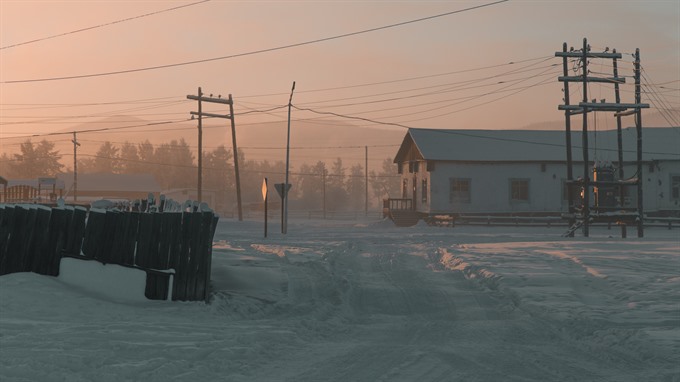 |
| Winter wonderland: Wooden houses covered in white snow, white smoke from chimneys, and the pink sky of winter in Oymyakon City. |
Bùi Thị Hồng Ngọc became the first Vietnamese to step on Oymyakon, dubbed the Pole of Cold, or the coldest inhabited place on Earth, with the lowest recorded temperature of -71.2 degrees Celsius.
She tells Việt Nam News about her unbelievable journey.
We departed from Moscow to Yakutsk, Sakha Republic in Russia, to arrive in the city located within the North polar circle of the Earth — Oymyakon. The runway was covered with thin ice although the workers clean it every hour to avoid sliding of airplanes during taking off or landing. From this city, my Russian companion and I started our once-in-a-lifetime adventure.
When we first stepped outside, it was -33 degrees Celsius. Just imagine when you open a refrigerator and cold air blows straight into your face, making you shiver. Normally the temperature of a refrigerator only reaches close to -18 degrees Celsius, so that cold in Yakutsk was double. Well, welcome to Yakutsk, the entrance of the Earth’s giant freezer refrigerator.
Yakutsk is the largest city in the world built on permafrost. The temperature remains -8oC frozen all year round at below four metres deep, while the temperatures above the ground change every minute. The condition is not favourable for constructions so each building must stand on concrete columns with a special structure to prevent ground melting.
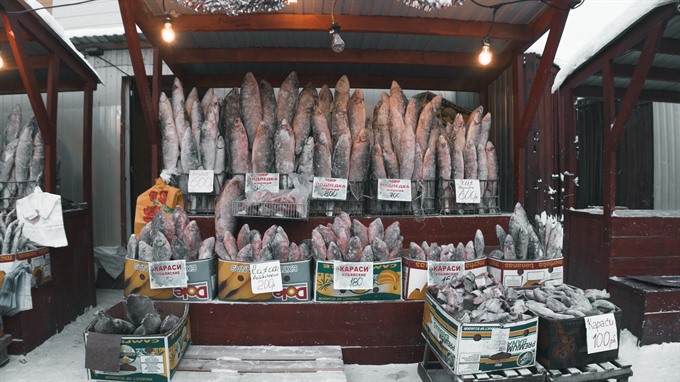 |
| No fridge needed: A market stall in Yakutsk sells frozen fish. — Photo Alex Okulovsky |
We arrived right on December 31, when the whole city was in a festive mood. Russian people were celebrating their biggest festival — Russian Christmas Eve — which ran until January 7.
They don’t celebrate Christmas on December 24. The simple reason for this is because Russians follow Orthodox Christianity and they use the Julian Calendar, while most other countries have adopted the Gregorian calendar. Their traditional symbols for New Year’s Eve and Christmas Eve are “Ded Moroz” (Grandfather Frost) and his granddaughter, Snegurochka, instead of Santa Claus.
That night, we followed local people to the mountain next to the city, from there, we had the best scene of a bonfire in the middle of snow-covered woods, full moon and the city covered in massive fireworks shooting from 100 locations at the same time. That night the temperature went down to -37oC and it was the first time I couldn’t feel my feet even when I had equipped myself carefully from toes to teeth.
When I recall my first impression of the city, the first thing I remember is the colour white. White snow was all over the streets, covering cars, roofs, trees, fences and everything else on the ground.
 |
| Covered in white: Hair and eyelashes are covered with snow and ice after just 15 minutes of walking. Photo Alex Okulovsky |
In my memory, the second impression was yellow of the light cast out from the windows of wooden houses and apartments. The yellow light represents living activities, the warmth of the fire and also tells me I would be warm again after 15-20 minutes of walking outside in this weather.
There, after every 15-20 minutes of being exposed to -30oC, I had to rush immediately into a car or some room to put my hands in front of a heater.
We had been planning for around half a year before the trip, because real cold, real winter, though beautiful, fun and worth experiencing, is definitely not a joke!
The 1000-km journey from Yakutsk to Oymyakon takes two days by car, without phone signal and rare chances to see a few houses of some hunters. Phone batteries drained like crazy and my iPhone died after three minutes of being exposed to the outside cold. Water turned into ice right in the bottle so we could not drink. There was just ice and snow everywhere and the eternal woods.
Adding to that, by the time we approached the coldest inhabited village on Earth, the temperature would drop fast especially at night when it could go down to -60oC and for an unprepared person, maybe one night outside in this weather is enough to use his lifetime insurance.
 |
| Chilled meal: Noodles are frozen within 15 minutes in minus 50 degrees Celsius. Photo Alex Okulovsky |
We both did prepare carefully for the trip, especially since I’m a girl from a tropical country. Therefore, reaching our target — Oymyakon Village in -60oC — is extremely challenging both physically and mentally.
My companion had prepared a reheater breather mask for me, which helps protect the lungs and airways from the damaging effects of extremely cold and dry air.
At -5oC, the cold seems refreshing with snow, which will be perfect for a vacation. But at -20oC, the moisture in your nostrils freezes, and breaths become heavier and it is hard to hold your cough. At -35oC, the air becomes as sharp as a knife, which makes frostbite a constant hazard, and at -45oC, metals or any frozen objects that stick to your exposed skin could tear off your flesh. I lost a piece of my tongue while tasting my frozen noodles at -54oC.
Before the trip, I intended to buy a thermometer for Oymyakon, but the best one I could find does not measure under -30oC. A special thermometer is required to measure this winter.
Not less important is a pair of Valenki, which is special ancient fleece high boots of Slavik people used for walking on dry snow when the weather is frosty.
Yakutia people prefer fur as it can keep them warm. Also, their bodies are much different from those from the South; for instance, their bodies do not require to cool themselves by the sweating mechanism so they rarely sweat, which is just simply a natural selection in their genes.
Foods here mainly contain protein because vegetables definitely cannot grow in this severe cold weather. However, local people have sufficient nutrition derived from animal milk and meat that can be easily stored in such conditions similar to that of a fridge. The Yakutsk’s fish market is definitely my favourite spot where for the first time I could see frozen fishes standing like statues.
In order to reach Oymyakon - Russian Far East, 1,000km from Yakutsk, we crossed Kolyma Highway, which is also known as the Road of Bones, constructed from 1932-53. The highway was given that name after hundreds of thousands of prisoners died while constructing it. Their bones and bodies were buried right on this permanent frost ground and integrated into the formation of the road.
Russian people welcomed me very hospitably. Even though I didn’t speak much Russian and they didn’t speak much English but their warm welcome erased all of my worries since the first days arriving in Moscow.
I remember Tamara, our host in Oymyakon, the village in the Far East with only 300 inhabitants but now the number is reducing. Tamara is responsible for welcoming people from all over the world to visit the village and also owns a homestay in this Pole of Cold.
We had a nice conversation with her about Oymyakon’s stories and I was surprised to learn that I was the first Vietnamese tourist among 56 other nationals, who have ever set foot on this coldest inhabited place on Earth.
The most interesting story was about how Yakut people deal with the corpses of the dead. They put the bodies inside a hollow stem and leave them in the forest, which is somehow similar to that of the Tibetans, whose corpses are wrapped and hung on trees so that the spirit can escape and become stars on the Milky Way.
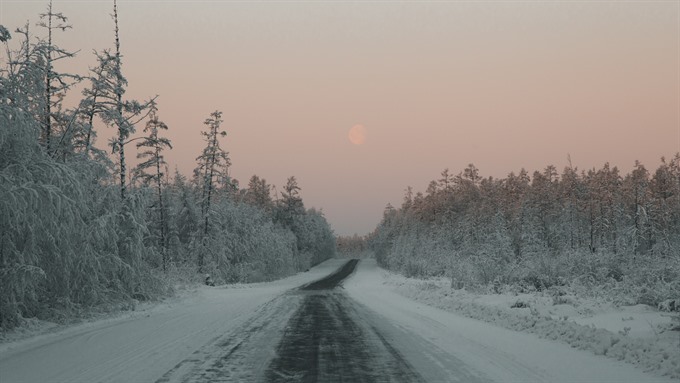 |
| Icy highway: Kolyma Highway – “Road of Bones” - leads to Oymyakon City. Photo Alex Okulovsky |
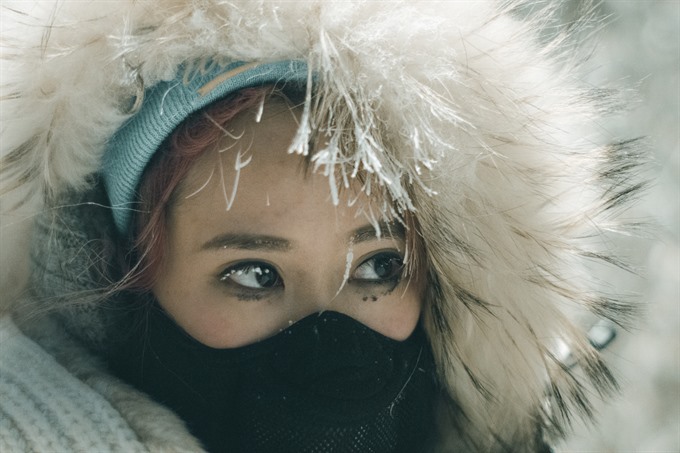 |
| Protection: A reheater breather mask helps protect the lungs and airways from the damaging effects of extremely cold and dry air. Photo Alex Okulovsky |
 |
| Wrap up warm: Yakutia children still go to school even when it’s minus 50 degrees Celcius, “if the school is cancelled, they go to play hockey” – Alexander Grinchuk, our local guide told us. Photo Alex Okulovsky |
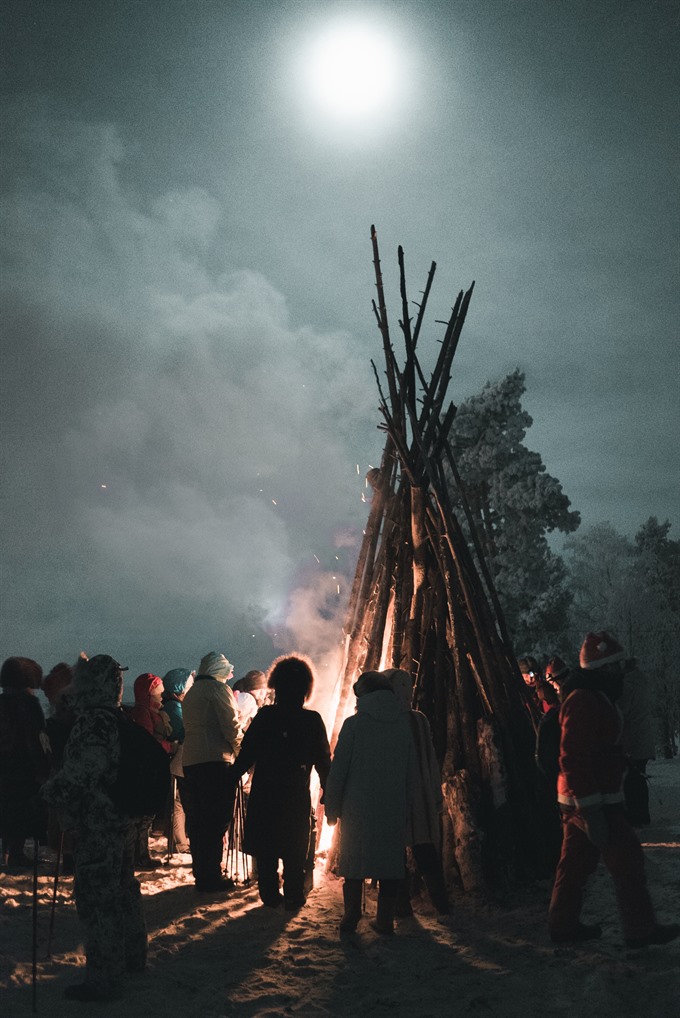 |
| Source of heat: A bonfire in the middle of snowy woods under the full moon on the mountain near Oymyakon City. Photo Alex Okulovsky |
 |
| Freezing: The writer receives a certificate from The Frost Keeper – Cheeshun in Oymyakon – The Pole of Cold. — Photo Alex Okulovsky |
However, Yakutsk people don’t really mind that because they cannot bury human bodies properly in this severe circumstance of nature. Where the top three metres of the ground tends to thaw in the summer and then freezes, people normally cannot dig deeper because of the hard ground of permafrost, and the buried subjects tend to rise to the surface after a while. It would be creepy if you buried someone three metres underground and then next year when you come back to visit him, his body would have risen up above the ground.
Tamara told me that she wanted to introduce to the world what real winter is, how cold it can be but also how beautiful it is. The place seems hard to reach but is also the liveliest place. Glimpsing into the woods, you might only see white colour and crooked branches and pine trees, but if you take a look deeper, slower, you will see the whole lively life inside.
When we went fishing with a local fisherman, we had to cross 15 minutes in the cold woods to reach the river, which had turned into ice. In order to catch fish, people have to dig holes on the ice and release nets and baits.
The fisherman was taking the nets from the icy river with his bare hands without being scared of frostbite while I went into a state of shock because of the cold. That could be the coldest hour I had ever experienced. We caught one fish and it turned into iced fish within five minutes on the ground.
The memories from this place often flash before my eyes — the images of a wooden village with white smoke rising from its house chimneys, people in fur and valenki walking on the white street, Laika sledge dogs happily welcoming new guests, and sunsets with orange-pink colour at 3pm every day.
We had a lot of fun throwing boiled water, which immediately got frozen, having our hair and eyelash covered with snow and ice under -54oC after 15 minutes of walking, underpants easily breaking after laundry, or tongue sticking to objects.
"That is the great paradox in Oymyakon," one local told me, "it seems impossible to live here but impossible to leave as well." VNS